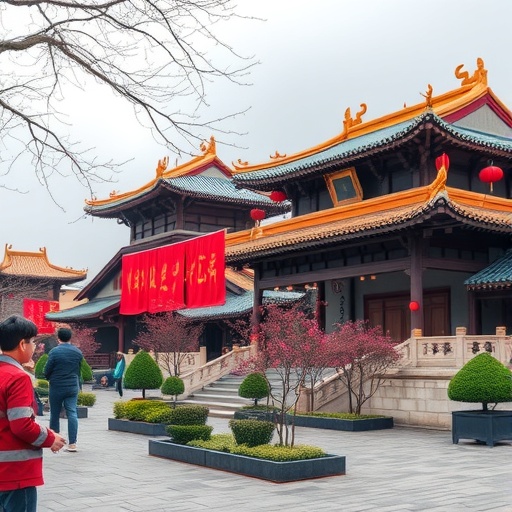
In a groundbreaking study set to be published in the esteemed journal Health Research Policy and Systems, researchers Xu, Y., Song, L., and Liu, X. embark on a comprehensive exploration of the intricate factors that shape health impact assessment (HIA) policy identification in China. This comparative examination, juxtaposing the health sector against its nonhealth counterparts, promises to illuminate the nuances that inform policy creation and implementation within one of the world’s most populous nations.
The study emerges from a growing recognition of the pivotal role that health impact assessments play in informing public policy. Ensuring that health considerations are integrated into all sectors of policy-making is crucial for fostering environments conducive to overall wellbeing. However, the researchers identify a notable disparity in how HIA policies are recognized and wielded across different sectors in China. By pinpointing these discrepancies, the research aims to establish a foundation for more effective policy frameworks moving forward.
Central to the comparison is an analysis of how various sectors prioritize health outcomes in their operations. The health sector, by its very nature, is expected to hold health improvement as a primary objective. Conversely, nonhealth sectors—spanning industries such as transportation, urban development, and agriculture—may not inherently prioritize health outcomes. This fundamental difference raises pressing questions about how health is considered and integrated into policies outside traditional health domains.
.adsslot_qEitMZaWw9{width:728px !important;height:90px !important;}
@media(max-width:1199px){ .adsslot_qEitMZaWw9{width:468px !important;height:60px !important;}
}
@media(max-width:767px){ .adsslot_qEitMZaWw9{width:320px !important;height:50px !important;}
}
ADVERTISEMENT
The researchers meticulously collected data from a range of sectors, employing interviews, policy document analyses, and case studies to gain insight into the perceptions and practices surrounding health impact assessments. This multi-pronged approach allowed for a comprehensive understanding of the factors influencing policy identification. Through qualitative narratives and quantitative metrics, they mapped the landscape of HIA across various contexts, revealing significant insights that had previously gone unnoticed.
Moreover, the study dives into the socio-political landscape that governs health policy in China. Understanding the interplay of governmental frameworks, policy priorities, and societal needs is crucial in deciphering the effectiveness of HIA policies. The researchers delve into how economic development pressures often overshadow health considerations in nonhealth sectors, leading to inconsistencies in policy enactment and assessment practices.
As the findings unfold, they highlight several barriers that hinder effective health impact assessments in nonhealth sectors. One such barrier is a lack of awareness and understanding of HIA among policymakers and sector stakeholders. Many in nonhealth sectors operate without a clear grasp of how health assessments can enhance the quality and effectiveness of their policies. This educational gap represents a crucial opportunity for advocacy and knowledge dissemination efforts aimed at bridging the disconnect.
The study also emphasizes the importance of stakeholder engagement in fostering effective health impact assessments. Engaging nonhealth sector stakeholders early in the assessment process is key to maximizing the relevance and applicability of health outcomes in their respective areas. By fostering collaborative dialogues that emphasize health’s significance, stakeholders across sectors can cultivate a more unified approach to policy-making.
An overwhelming theme that emerges from the research is the call for integrated approaches to health impact assessments. The notion that health considerations should extend beyond the confines of the health sector resonates throughout the findings. The researchers argue that, to achieve holistic health outcomes, there must be an integrated framework promoting interdisciplinary collaboration between health and nonhealth sectors.
In the context of an ever-evolving health landscape, the urgency of this research cannot be overstated. With global health challenges such as pandemics, lifestyle diseases, and environmental impacts on health becoming increasingly intertwined, the need for policies that holistically address health becomes paramount. The study makes a compelling case for the necessity of ongoing evaluation and adaptation of health impact assessments, ensuring policies remain responsive to the changing dynamics of society.
Moreover, the implications of this research extend beyond China. As countries worldwide grapple with similar challenges regarding health policy integration, the comparative insights garnered from this study can inform international discussions about best practices in health impact assessments. There is a growing appreciation for the need to share knowledge and experiences across borders to promote public health more effectively.
The researchers conclude with a set of recommendations aimed at enhancing health impact assessment practices in both the health and nonhealth sectors. By advocating for comprehensive guidelines that clarify the role of HIA, enhancing training programs for policymakers, and promoting interdisciplinary collaborations, there exists significant potential to advance public health initiatives through more informed policy-making.
In essence, this study is poised to be a landmark contribution to our understanding of health impact assessments and their role within policy frameworks in China. By unveiling the complex interplay of factors influencing policy identification, the researchers pave the way for more robust, effective health policies that ultimately enhance the quality of life for the Chinese population. The work emphasizes not only the critical link between policy and health but also the broader implications for creating sustainable, healthy communities in an increasingly interconnected world.
The potential for this research to inspire similar studies in other regions highlights the universal relevance of health impact assessments in policy-making. As governments and organizations strive to navigate the complexities of public health, this study represents a vital step towards informed, evidence-based decision-making that prioritizes well-being across all sectors.
Ultimately, as policymakers reflect on the findings presented in this compelling comparative study, the hope is that they will embrace the call to action for more integrated, health-conscious approaches to policy development. Through collaborative efforts, informed dialogues, and a commitment to inclusivity, the vision for a healthier future can become a reality—one where the significance of health informs every facet of policy-making.
Subject of Research: Factors Influencing Health Impact Assessment Policy Identification in China
Article Title: Exploring factors influencing health impact assessment policy identification in China: a comparative study of health and nonhealth sectors.
Article References:
Xu, Y., Song, L., Liu, X. et al. Exploring factors influencing health impact assessment policy identification in China: a comparative study of health and nonhealth sectors.
Health Res Policy Sys 23, 76 (2025). https://doi.org/10.1186/s12961-025-01312-0
Image Credits: AI Generated
DOI: 10.1186/s12961-025-01312-0
Keywords: Health Impact Assessment, Policy Identification, Public Health, Comparative Study, China, Nonhealth Sectors.
Tags: comparative health sector analysisdisparities in HIA policieseffective policy frameworks for healthfactors influencing health policyhealth considerations in policy-makingHealth impact assessment in Chinanonhealth sector health outcomespolicy creation in populous nationspublic health policy integrationsector-specific health prioritiestransportation industry health assessmentsurban development and health impact





